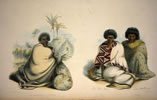Crown views of the treaty
Colonial officials mainly interpreted te Tiriti o Waitangi (the Treaty of Waitangi) on the basis of its English-language text, which placed less emphasis on maintaining the authority of rangatira than the Māori-language version. Within four years of the signing, officials admitted that the traditional rights of rangatira would have to be limited because they conflicted with Crown authority.
Even though many rangatira did not sign the te tiriti, the British government insisted that it placed all Māori under British authority. Government agents and successive governors asserted that the treaty gave protection and guarantees to Māori, but sometimes these intentions conflicted with official practice in handling legal and land issues. Violence between settlers and Māori at Wairau in 1843 and war in Northland in 1845 were early precursors of more serious battles to come. Occasionally the government chose to ignore te tiriti altogether. For example, the government succumbed to pressure from the New Zealand Company and validated its dubious purchases of Māori land to establish the town of Wellington.
Māori views of the treaty
Many Māori doubted that the Crown would uphold its obligations under te tiriti. Those doubts were confirmed in the decade after it was signed. The ‘protector of aborigines’, appointed by the government to defend Māori interests, became compromised by acting as a land-purchase negotiator. The position was abolished in 1846. In 1847, concerns that the Crown might seize uncultivated Māori land prompted an appeal from Waikato chief Te Wherowhero to Queen Victoria. Her assurance that treaty guarantees would be honoured was delivered to Māori by Governor George Grey.
Irrevocably binding compact
In his 1860 book criticising government policy in Taranaki, William Martin, a former chief justice, wrote, ‘Here in New Zealand our nation has engaged in an enterprise most difficult, yet also most noble and worthy of England. We have undertaken to acquire these islands for the Crown and for our race, without violence and without fraud, and so that the native people, instead of being destroyed, should be protected and civilized … The compact is binding irrevocably. We cannot repudiate it so long as we retain the benefit which we obtained by it.'1
Changing balance of power
The government’s intention to honour the treaty is shown by many of its early dealings with iwi. However, in the 1840s the government had little or no authority in many parts of the country. The colonial Parliament, which first sat in 1854, hoped to acquire more substantial power and authority, and was not prepared to share that authority with Māori. Māori were, in effect, excluded from participating in political decisions at a national level.
Māori signatories were often eager for more – and profitable – contact with Pākehā, but the numbers of European colonists arriving in key settlements such as Auckland, Wellington and Nelson came as a shock. The settlers’ determination to acquire Māori land in or near these settlements was threatening to local Māori who did not wish to sell their land. In most other areas, however, life went on much as usual as iwi and hapū retained control over their tribal lands. In many regions, settlers relied on Māori for protection, food supplies and assistance. In the 1840s the power balance between Māori and European still favoured Māori in most areas.
The Māori King movement
Over the 1840s and 1850s European settlement expanded and tensions over land worsened. Many iwi responded by strengthening their traditional rūnanga. Waikato iwi formed an alliance, aiming for unity and drawing in iwi from other regions. In 1858 the Tainui chief Te Wherowhero was appointed head of this alliance and renamed Pōtatau, becoming the first Māori monarch. One aim of the Kīngitanga (the King movement) was to retain land by withholding it from sale. The Kīngitanga believed that the Māori king and British queen could coexist peacefully.
Pākehā attitudes to the treaty
By the end of the 1850s, Pāhekā opinion on te tiriti was divided. Some settlers, such as William Martin (who wrote a book on the subject), felt that the honour of the Crown was at stake in upholding the treaty’s promises. Others thought that the treaty was not compatible with the advancement of European settlement. Government officials regarded the Māori king as a treasonable challenge to British sovereignty, so conflict between the Crown and Māori became almost inevitable.

